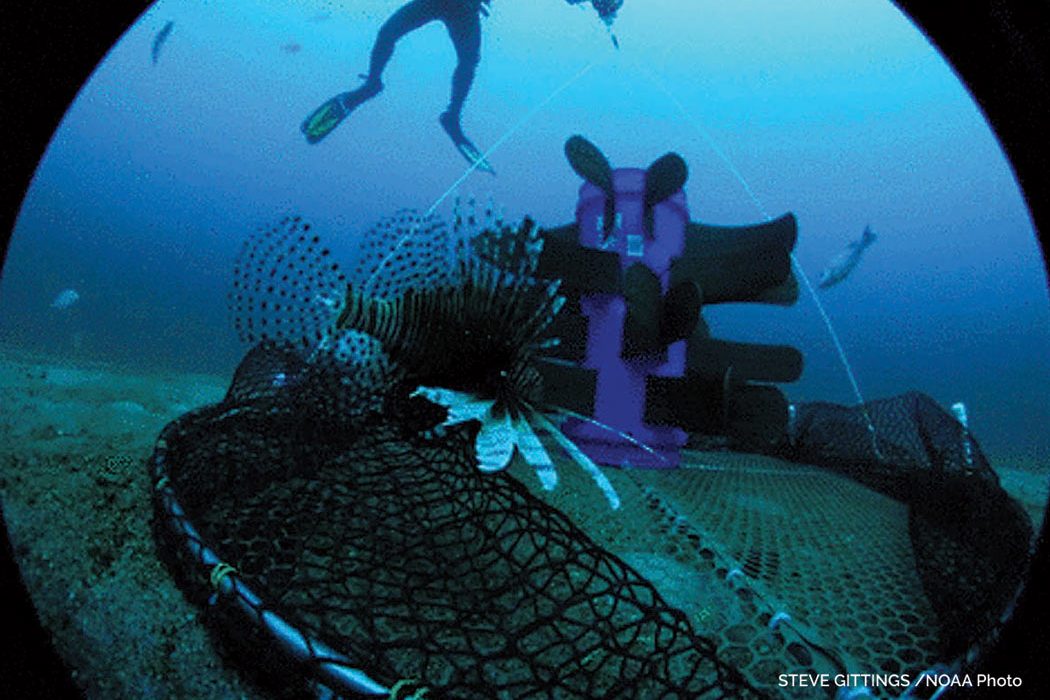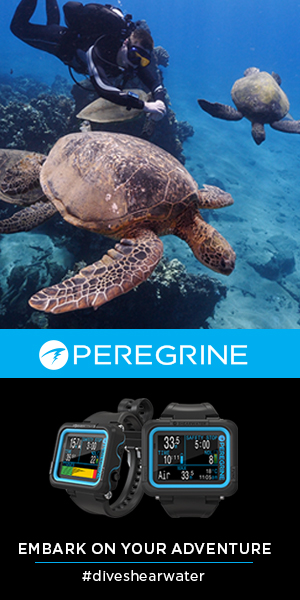Pictured above: An invasive lionfish in front of a curtain-style trap. Steve Gittings/NOAA Photo.
NOAA and its partners have developed and released designs for new lionfish traps that could provide the first realistic means of controlling invasive deep-water lionfish populations and support the development of a lionfish fishery.
“These new designs have the potential to help fishermen meet a growing demand for lionfish in the seafood market and speed up removal of these voracious invaders,” said Steve Gittings, Ph.D., chief scientist for NOAA’s Office of National Marine Sanctuaries and principal designer of the new traps. “This is a double win as it helps protect ecologically, recreationally, or commercially important native species while promoting a potential fishery.”
Known for their distinctive lionlike mane of fins and their venomous spines, Indo-Pacific lionfish have invaded reef ecosystems in the Atlantic Ocean, across the Gulf of Mexico, and throughout the Caribbean over the past several decades. Some large grocery chains occasionally sell lionfish. However, despite increasing restaurant and grocer demand, the market for lionfish has not grown to its potential because the supply is inconsistent.
Gittings worked with the nonprofit organizations Coast Watch Alliance and Lionfish University, as well as the University of Georgia, to develop and test various designs for lionfish traps and produce a construction guide. He said his goal was to come up with a design that minimizes bycatch, meaning it only catches lionfish. Also, the traps are designed to avoid what’s known as “ghost fishing” which occurs when lost traps continue to catch fish. The traps are constructed for easy deployment and retrieval, and for easy transport on fishing boats.
The basic concept behind the new traps, which anyone with minimal metalworking skills can build, is that lionfish tend to congregate around structures on the ocean floor. Instead of bait, structures in the center of the traps, called fish aggregation devices, or FADs, lure the fish in.
Because other fish species don’t tend to remain as close to home structures as lionfish, these kinds of traps catch virtually nothing but invasive lionfish. Gittings’ first prototype lionfish trap uses net curtains that closed around a cube-shaped PVC frame, trapping the fish inside; the frame of the second-generation lionfish trap, called a dome trap, lies flat on the seafloor and closes over the FAD. When hauled up by ropes attached to each jaw, the trap closes like a clam around the FAD, capturing any fish hanging out there. Gittings says both trap designs are now ready for the fishing community in the U.S. and Caribbean to build and test, particularly for use in waters beyond scuba depths. The construction guide provides a starting point for interested parties to further develop and improve the traps. Changes in trap construction materials, shape, size, mesh choice, opening and closing mechanisms, and FADs are among the potential refinements.
Because fish traps are prohibited in U.S. federal waters in the Gulf of Mexico and South Atlantic, users must consult with federal and local authorities to obtain the necessary authorizations before testing the devices. Also, fishing groups or individuals testing these lionfish-specific trap designs are asked to share their experiences on social media and with NOAA so everyone can benefit.
“We are now seeing large lionfish populations in deep water, and have evidence of impacts to native ecosystems,” Gittings said. “We can’t wait any longer to take action.”
To download the lionfish trap construction guide, please visit:
sanctuaries.noaa.gov/science/conservation/lionfish-trap-guide.html






